Twinkle Dice Game Review
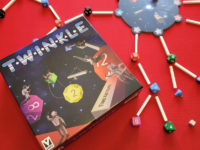
“Star light, star bright,
First star I see tonight;
I wish I may, I wish I might,
Have the wish I wish tonight.”
Have you ever stared up at the night sky and thought, “I can do that.”
Well, now’s your chance! In Twinkle, players take on the role of celestial creators decorating the night sky with beautiful constellations. The player who can do this the best will be the King Celestial!
How to play Twinkle
Setup:
To set up Twinkle, players place the board in the center of the table so that each pair of Starting Stars are facing a single player. Players then receive the matching color Scoring marker of the Starting Stars facing them.
Players shuffle the Scoring cards and deal the number of players +2 face-up near the playing area along with the Twinkle Scoring card. Next, dice of the matching color are placed next to each Scoring card, except the D8 dice. Those are rolled and placed on the board in the center of the table.
Each player takes 7 Connectors and the player who most recently saw a shooting star goes first.
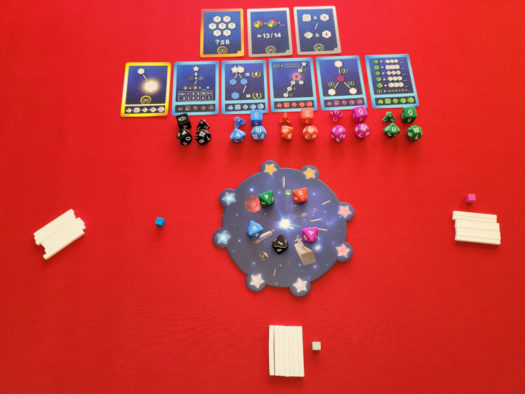
Game Play:
The game is played over 7 rounds where players add stars to their constellations. Once the last player has placed their 7th star, the game ends and players calculate their scores.
On a player’s turn, they’ll do the following 2 steps:
1. Choose 1 die.
This can be done in a couple different ways:
-
- Choose 3 available dice from in front of the Scoring cards or the center Board. Roll those dice and choose 1, returning the rest to their Scoring card or to the center Board if it’s a D8.
- Choose one D8 from the center Board without re-rolling it.
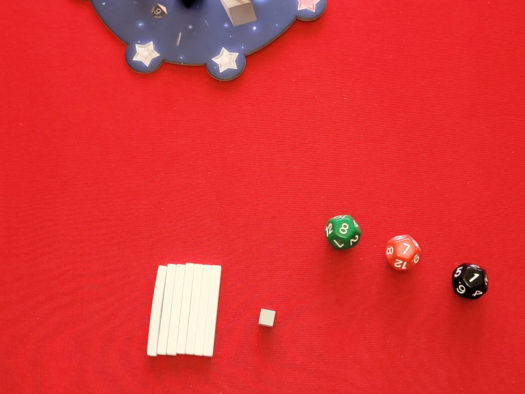
2. Place the die.
Once a player has chosen a dice, they add it to their constellation. To do this they’ll use one of their Connectors and place it after one of their Starting Stars or one of their previously played dice. Then they add the die they just chose to the other end of the Connector.
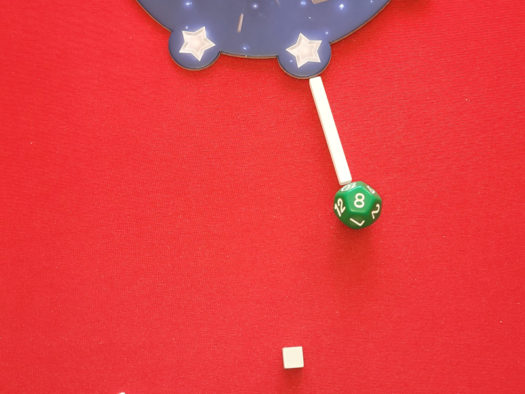
There are some rules that must be followed when placing dice.
- Every new die placed must have a lower value than the previously placed die it’s connected to. The exception is connecting to one of the Starting Stars.
- Each Starting Star and die may have at most 2 Connectors attached to them.
- A player must always add a die to their constellation during their turn if possible.
After adding a new die to their constellation, play passes clockwise to the next player. This continues until all players have played 7 dice into their constellation. At which time the game ends and players score their constellations.
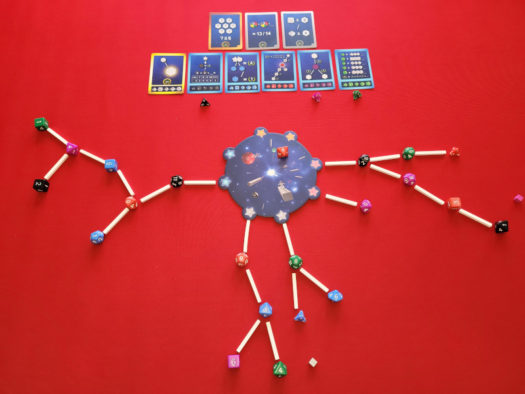
Final Scoring:
When the game ends, players flip the center board and track their scores on the opposite side. Players score points based on each Scoring card that was drawn at the beginning of the game. Going card by card, players earn points based on how their constellation matches up to the card being scored. The player who has the highest score wins.
Here’s a quick breakdown on how each Scoring card scores:
- Yellow Scoring card. Players score points based on how many yellow dice are in their constellation.
- Blue Scoring card. Players score 1 point for each blue die not paired with another or 4 points if paired with another blue die. To be paired, the two dice must be directly connected to the same Starting Star or previously placed die.
- Green Scoring card. Players score points for other dice in their constellation that match the type (d4, d6, d8, etc.) of any green dice they have. 1 point per matching dice plus 1 point for the green die itself.
- Black Scoring card. Players score 1 point for a single black die in their constellation. If there are more black dice they score points based on the sum of all the black dice connected to a Starting Star. Be careful, get too high of a total and the points start to go back down.
- Purple Scoring card. Players score 1 point for each Connector on each purple dice.
- Red Scoring card. Players score points for each odd or even die in the same line as the red die. If the red die is even, then odd dice score. If it’s odd, then even dice score. A line is considered to be a group of stars starting at the Starting Star and going to the end of the line.
- Twinkle Scoring card. Players score 2 points for connecting a new die with more sides and a lower number to a previously played die.
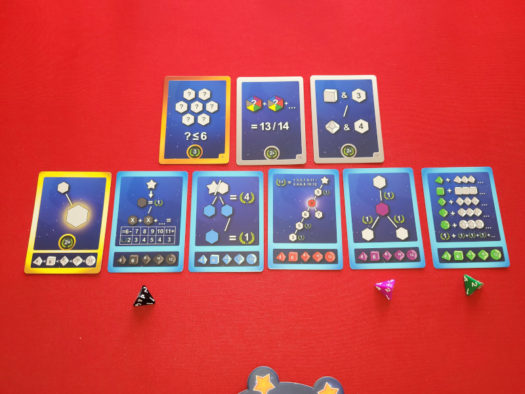
The game also comes with Bronze and Silver Mission cards that give players points for achieving different goals throughout the game. This allows for more ways to play including:
- Bronze level. Players randomly draw 1 Bronze Mission card during setup which will be scored at the end of the game.
- Silver level. Players randomly draw 2 Silver Mission cards during setup which will be scored at the end of the game.
- Diamond level. Players randomly draw 1 Bronze Mission card and 2 Silver Mission cards during setup which will be scored at the end of the game.
There’s also a solo mode where the player tries to score at least 20 points based on the combination of Scoring cards and Mission cards depending on the level. There are 40 levels in total.
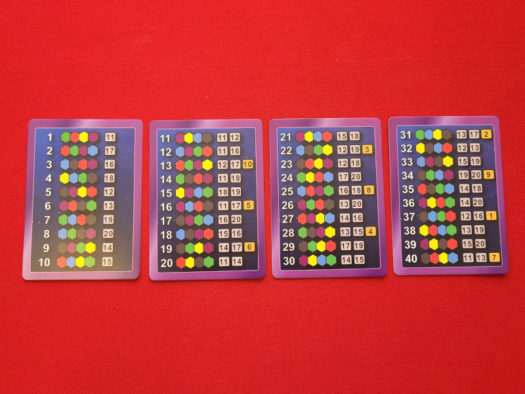
The Breakdown of Twinkle
At first glance, I would not have grabbed Twinkle off the shelf. The box cover is not very interesting and games about stars don’t usually capture my attention. But, as the saying goes, “don’t judge a book by it’s cover.”
Theme and Mechanics:
As mentioned above, the theme for Twinkle is constellation building – although it could be classified as an abstract game. That said, the way the table looks at games end, definitely gives you a stellar vibe.
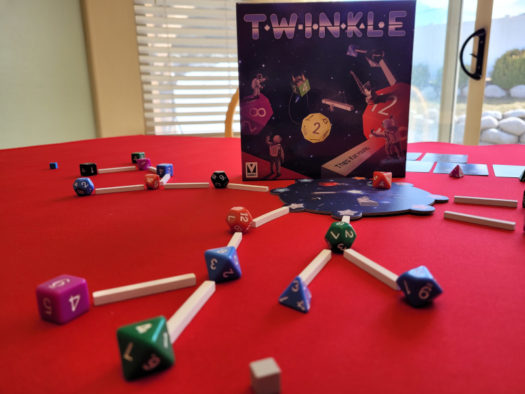
Theme aside, I really enjoy the mechanics of Twinkle. Dice chucking is always fun and the strategy behind choosing and placing dice is awesome. For example when you choose a die you’re not only choosing for yourself but you’re also taking away a choice from other players. So do you choose to really help yourself or to slow down your opponents?
Flow and accessibility:
Twinkle boasts a play time of 15 minutes and I’d to say that’s pretty close. However, if you’re playing with someone that has difficulty making choices, it could take longer. You could mitigate that with a timer of some sort if needed.
The biggest learning curve for Twinkle is the Scoring cards. There are 7 main ones and several Bronze and Silver mission cards that can be added in. While the mission cards aren’t too hard to figure out, it does take a little bit to get the score cards down. My suggestion here is to make sure and read through all the examples given in the rule book and take advantage of the glossary of mission cards.
A downside of the Scoring cards is they can become quite daunting to keep track of over the course of the game. Again adding to the downtime between turns.
Once the Scoring cards are figured out, the game is a breeze to teach. The recommended age range is 8+ and I’d to agree with that. I also feel like Twinkle makes a great gateway game for non-gamers, but has good enough decision making that the avid gamer can enjoy it.
Production Value:
All the components for Twinkle are really good quality. The cards and board are thick, the Connectors are wooden, and the dice are solid.
The artwork is okay. Like I mentioned before, it didn’t grab my attention. However, the gameplay more than makes up for it.
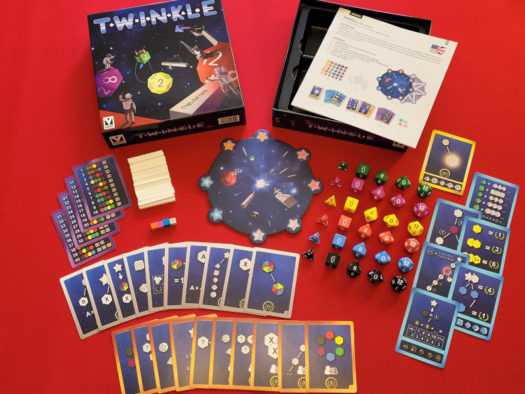
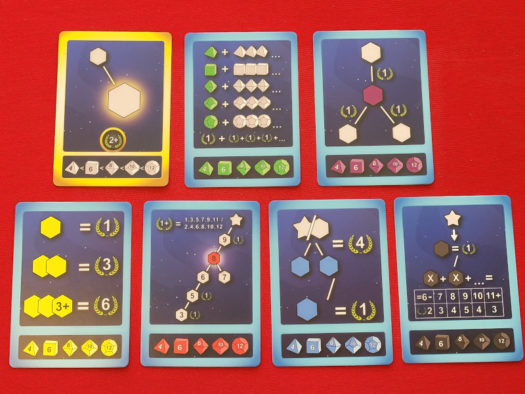
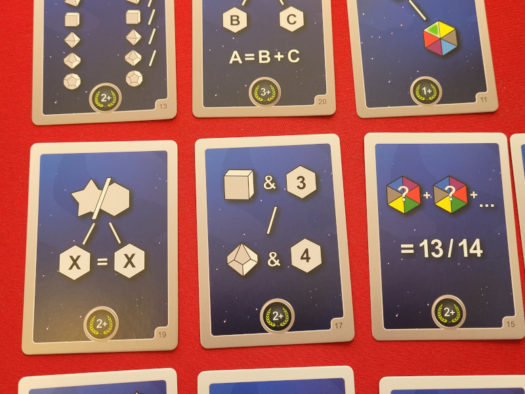
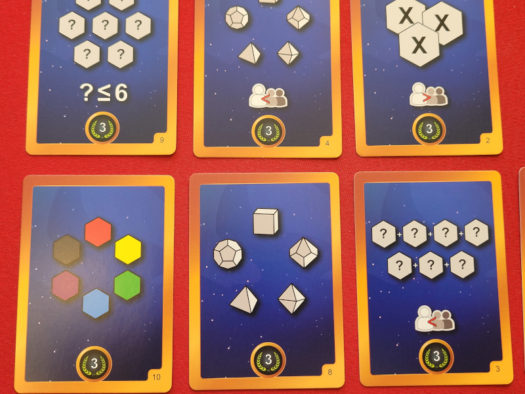
How does Twinkle score on our “Let’s Play Again” game meter?
Twinkle is a surprisingly good game that scores pretty high on our “let’s play again” game meter. I’d wholeheartedly recommend it to my other gaming friends and will definitely be playing it again.
The number of Bronze and Silver mission cards adds for a lot of replayability. Even though I mentioned it being hard to keep track of all the different Scoring cards and missions, I’d always prefer to play at Diamond level. I actually love having all the different scoring options available.
All that said, I think Twinkle really shines in solo mode. In each level, players are combining different Scoring cards with Bronze and Silver mission cards needing to score more than 20 points each time. This creates a good mix of challenging puzzles over the 40 missions!
About the Author
Dane is an Advertising and Layout Manager for a national magazine by day and a husband, father of four, and board gamer by night. He has a passion for board games and believes board games help bring families closer together while providing kids a unique way to learn many diverse skills. And he thinks they’re downright fun!!!
The Board Game Family would like to thank V Games for a review copy of Twinkle.


